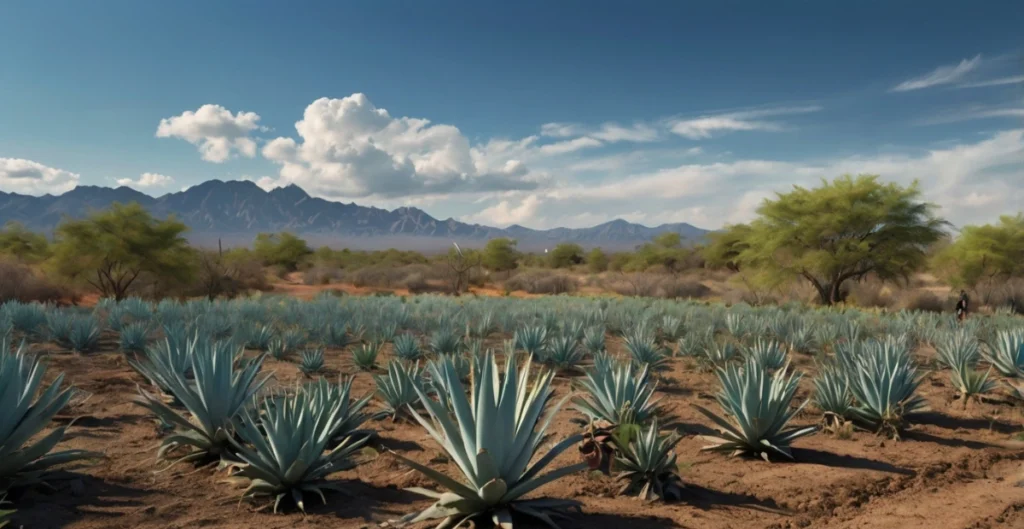Imagine standing under a vast, open sky, surrounded by fields of blue agave plants. Their striking, sword-like leaves seem to stretch endlessly, forming an awe-inspiring sea of green and blue hues. These plants are more than just a sight to behold; they are an integral part of history, culture, and modern life. Whether you’re fascinated by its traditional roots, intrigued by its culinary uses, or considering growing one at home, the blue agave plant offers endless wonders to discover.
advertisement
Let’s delve into the remarkable world of the blue agave plant and explore why it continues to captivate the hearts and minds of people worldwide.
What is the Blue Agave Plant?

A Brief Overview
The blue agave plant, scientifically known as Agave tequilana, is a succulent native to Mexico. Its distinctive rosette of spiky, bluish-green leaves sets it apart from other plants, making it a visual marvel. Thriving in arid climates, the blue agave has adapted to withstand harsh conditions, storing water in its fleshy leaves and creating a striking silhouette against desert landscapes.
The Cultural Significance
For centuries, the blue agave plant has been a symbol of Mexican culture and tradition. It is deeply intertwined with the country’s heritage, most notably as the primary ingredient in tequila production. Beyond tequila, the plant has been used in ceremonies, crafts, and even as a source of sustenance, highlighting its versatility and importance.
advertisement
The Life Cycle of the Blue Agave Plant

From Seed to Harvest
The journey of a blue agave plant is a slow yet rewarding one. It begins as a tiny seed or a pup (a small offshoot from a mature plant). Over the course of 8 to 12 years, the plant matures, developing its signature leaves and a central piña, or heart, which holds the sugars essential for tequila production. This long maturation process underscores the dedication required to cultivate this incredible plant.
Sustainability and Growth Challenges
While the blue agave plant is resilient, its cultivation faces challenges. Overharvesting and monoculture farming have put pressure on its natural ecosystem. Sustainable practices, such as crop rotation and biodiversity initiatives, are crucial to ensuring the plant’s future.
Uses of the Blue Agave Plant
Tequila Production
advertisement
Tequila, one of Mexico’s most celebrated exports, owes its unique flavor and character to the blue agave plant. The process begins with harvesting the mature plants and extracting their piñas. These are then cooked, crushed, and fermented to produce the beloved spirit. The designation of origin ensures that authentic tequila is made only in specific regions of Mexico using traditional methods.
Agave Nectar and Sweeteners
For those seeking natural alternatives to sugar, agave nectar is a game-changer. Extracted from the blue agave’s piña, this sweetener boasts a low glycemic index, making it a popular choice for health-conscious individuals. Its mild flavor complements a variety of recipes, from beverages to baked goods.
Environmental Benefits
Beyond its culinary and cultural uses, the blue agave plant offers environmental advantages. Its ability to grow in arid regions makes it an excellent option for erosion control and reforestation efforts. Additionally, researchers are exploring its potential as a source for biofuels, further showcasing its versatility.
The Blue Agave in Your Kitchen
advertisement
Agave Nectar Recipes
Bring the blue agave plant into your kitchen with these simple and delicious recipes:
| Recipe | Ingredients | Instructions |
|---|---|---|
| Agave Lemonade | – 2 tbsp agave nectar | – Mix agave nectar, lemon juice, and water. Serve chilled. |
| Agave Granola Bars | – 1/4 cup agave nectar, oats, nuts | – Combine oats, agave, and nuts. Press into a pan and bake until golden brown. |
| Agave Salad Dressing | – 1 tbsp agave nectar, olive oil | – Whisk together agave, olive oil, and vinegar. Drizzle over fresh greens. |
These recipes highlight the plant’s versatility, allowing you to enjoy its natural sweetness in everyday meals.
Caring for and Growing Blue Agave Plants
Ideal Conditions
If you’re inspired to grow your own blue agave plant, you’re in for a treat. These low-maintenance plants thrive in:
- Soil: Well-draining, sandy soil is ideal.
- Sunlight: Full sun is a must for healthy growth.
- Watering: Minimal watering; let the soil dry out completely between waterings.
advertisement
Tips for Beginners
Starting with a small pup from a mature plant is the easiest way to grow blue agave at home. Be patient, as it can take years for the plant to reach full size. Consider planting it in a pot if you’re in a cooler climate, as these plants prefer warmth and cannot tolerate frost.
Frequently Asked Questions About the Blue Agave Plant
What makes the blue agave plant unique?
The blue agave plant’s striking appearance, resilience, and versatility set it apart. Its ability to thrive in harsh climates while offering a wide range of uses makes it truly special.
Can I grow a blue agave plant at home?
Yes! With the right conditions, you can grow blue agave plants at home. Ensure ample sunlight, well-draining soil, and minimal watering for best results.
Is agave nectar healthier than sugar?
Agave nectar is often considered a healthier alternative to sugar due to its lower glycemic index. However, it should still be consumed in moderation.
Conclusion
advertisement
The blue agave plant is a testament to nature’s beauty and ingenuity. From its iconic role in tequila production to its environmental and culinary applications, this plant continues to inspire and enrich our lives. Whether you’re savoring a margarita, sweetening your tea, or cultivating a plant at home, the blue agave offers something for everyone.
Ready to embrace the wonders of the blue agave plant? Start your journey today by trying a recipe, planting a pup, or simply raising a glass to this extraordinary plant!


